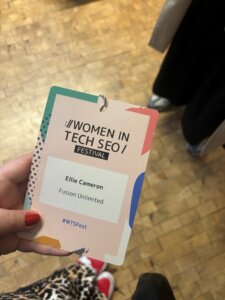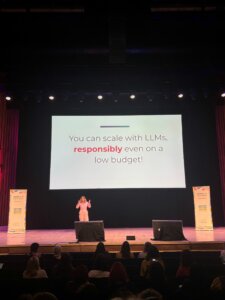Last Thursday, Ellie, our Senior SEO Analyst, and Lucy, one of our Content Executives, headed down to London for the Women in Tech SEO Fest 2025 in London. Find out what they got up to with a jam-packed conference schedule at The Barbican, followed by a networking after-party!
What is the Women In Tech SEO conference?
The Women in Tech event is a global Tech SEO conference series designed to empower and connect women and marginalised genders in the SEO and digital marketing industry. Each full-day event features 10 expert speakers across four key themes:
Analyse: Industry insights and analytical approaches.
Advance: Advanced strategies and future-proofing techniques.
Innovate: Emerging technologies and innovative strategies.
Empower: Career development and personal growth.
This year, the conference was held at the Barbican Centre in Central London, one of Europe’s largest performing arts centres. The conference was split between one of the two theatres for the talks and the beautiful conservatory, where the networking event was hosted.

Our day at WTSFest
WTS Fest was an incredible experience. Although it was a busy day, the three-hour train ride from Leeds was worth it. We arrived at the Barbican Centre at 9 a.m., ready to pick up our passes and register. Neither of us had been to a conference as big as WTS Fest before, so we weren’t expecting such a beautiful set-up!
Upon first entering the exhibition space, we were warmly welcomed (and offered plenty of merchandise) by exhibitors who were excited to share the latest features of their software.
One of our favourite freebies was a Screaming Frog badge, which we will forever treasure in the Fusion office and Areej Abu-Ali’s (one of the founders of the Women In Tech SEO) brand new book, Community Building for Marketers, which we are so excited to read!
Then, we were directed to the theatre for the talks to begin. The conference talks were varied, each having essential insights that we are so excited to share with our SEO team here at Fusion. They included:
- Who’s Been Messing Up Everything? It Was SEO All Along – Alice Rowan
- SEO Website Migration: Why It Has Become an In-Demand Skill – Rebecca Yu
- Personalising Product Categories with Faceted Navigation – Naomi Francis-Parker
- Elevating SEO: How to Win Executive Buy-in & Support – Chase Kreuter
- Scaling Smart: Ethical AI Strategies for SEO on a Tight Budget – Emina Demiri-Watson
- “It Was in My SEO Strategy BEFORE It Was Trendy”: Unleash the Power of Social Trends for SEO – Meg Sharma
- Shared Goals, Shared Success: How PPC & SEO Teams Can Win Together – Sophie Fell
- The Accessibility Advantage – Lyssa-Fêe Crump
- Navigating the Workplace as a Disabled Person in SEO – Chloe Smith
- The Art of the Ask – Shola Kaye
Ellie’s favourite talks
One of my favourite talks of the day was Emina Demiri-Watson’s Scaling Smart: Ethical AI Strategies for SEO on a Tight Budget. Part of the ‘Advance’ theme, this talk covered everything from AI gender bias and the importance of using AI ethically to top tips for ensuring your AI data is as accurate as possible.
I’ve long been interested in how AI can improve SEO strategies. Emina highlighted the importance of being picky when choosing the best LLM for our requirements. Automating processes can speed up work output, but at what cost?
Bias, privacy, and the environment are all key issues that companies (and people) should consider when using AI. Emina pointed out an AI gender bias early on in her talk that would have been laughable if it wasn’t so accurate. She instructed DALL-E! to create an image of her winning a boxing match. The LLM created an image of her standing in a boxing ring with her hip popped out to the side – obviously, this wasn’t recreated when asked to create a picture of a man winning a boxing match.

We’d all assume, or at least hope, that gender bias hasn’t found its way into AI, but sadly, this isn’t the case. One significant example of an AI gender bias was the AI-powered recruitment tool that Amazon created in 2014 to streamline the hiring process by rating resumes. By 2015, it was discovered that the system was biased against women. Since the AI was trained on resumes submitted over the past decade, mostly from male applicants, it learned to favour men, penalising resumes containing the word ‘women’s’ and downgrading graduates from all women’s colleges. Despite efforts to correct the bias, Amazon discontinued the project in early 2017. This case highlights one of the many risks of using AI without oversight and human input.
As AI expands and is used on a broader scale, companies must develop an AI code of conduct to ensure they use and create tools that avoid bias and data privacy violations while being transparent with clients.
Read our guide to 5 practical uses of ChatGPT for UK brands.

I also found The Accessibility Advantage presented by Lyssa-Fêe Crump, part of the ‘Innovate’ theme, incredibly insightful. As SEOs, we all know the importance of accessibility regarding website content and structure. Still, with over one billion people globally having disabilities, you’d think that every website would have accessibility at the top of its list. Unfortunately, this isn’t the case.
Lyssa-Fêe took a deep dive into some of the key parts that can make a website more accessible, including:
- Colour: When designing websites, it can be easy to overlook making text stand out from the background, especially if a client is set on a specific colour scheme. Using a colour contrast checker helps ensure that text is easier to read for the visually impaired.
- Keyboard Navigation: Ensure that the site can be navigated only via keyboard, as many assistive technologies rely on keyboard-only navigation.
- Headings: Using the correct title tags and heading structure is helpful for search engines but also essential for screen readers. A proper layout allows the screen reader to read the content provided in the correct order, avoiding any confusion that could make the page redundant to your users.
Although accessibility is essential from a legal compliance perspective, Lyssa-Fêe noted that having a highly accessible website also helps expand a site’s audience, improve ROI, and foster general business growth. I think bringing attention to this can be key when talking to clients and stakeholders who may not see accessibility as a priority in Technical SEO.
Lucy’s favourite talks
One of the standout talks I attended was Meg Sharmaj’s Social & SEO Trends, which was packed with valuable insights about tapping into current and upcoming trends (think Brat Summer) on social media and how SEO content and social media content can work together, whether on a micro or macro scale.
This information was valuable as I have been kickstarting Fusion’s social media channels, which have been back up and running for the last few months.
She introduced the diffusion of innovation theory, which explains how trends slowly build up before they explode into the mainstream. This fascinating concept makes you realise that trends don’t just appear out of nowhere; they follow a clear adoption pattern, from early adopters to the broader public. This is especially important for SEO professionals because spotting a trend early can give us a significant edge.
Meg also explained how different social platforms have unique ways of creating and spreading trends. On Instagram, for instance, hashtags play a massive role in shaping how content gets discovered and shared. It’s all about jumping on the right hashtag at the right time. On the other hand, Reddit thrives on community-driven trends, with subreddits driving discussions that often lead to viral moments. And then there’s TikTok, where it’s all about the sound bites, with trending sounds becoming the heartbeat of viral content.
I found Meg’s advice on using these trends in blogs exciting. She suggested that, while it’s tempting to latch onto the latest buzz, we need to think strategically about keeping these trends relevant over time.
The trick, she said, is to update content as trends evolve continuously. That way, your posts stay fresh and continue to rank well. It’s about incorporating new traits of a trend as it develops so your content doesn’t just become stale or outdated.
This got me thinking about the long-term value of keeping track of trends. Sure, we all know how to ride the wave of a trend in the short term, but thinking long-term and adapting content as trends shift can help maintain your SEO rankings. It’s all about staying ahead of the curve, being flexible, and knowing when to tweak your content so it keeps resonating with readers and search engines alike.
In short, Meg’s talk was a brilliant reminder of how important it is to be proactive with trends, not just reactive. By understanding the lifecycle of trends, from the micro-movements to the macro shifts, you can fine-tune your SEO strategy and ensure your content stands the test of time.

Naomi Francis Porter’s talk on Product & Service Categories was another highlight of the day, offering practical tips for refining how we present products and services online.
Did you know that 51% of people prefer personalised content? That’s a massive chunk of your audience! It drove home the importance of delivering tailored experiences and how that can impact everything from user experience to conversion rates.
Naomi explained that product categories need to be super easy to navigate. When customers land on your site, they should be able to find what they’re looking for quickly and without frustration. The main product category should be visible at the top of the page, and from there, you can guide them down personalised paths based on their interests or past behaviour. It’s all about simplifying the journey while making it relevant to each visitor.
One of Naomi’s top tips for personalisation was to tap into your customer service team for insights. They’re on the front lines, speaking with customers daily, so they’re a goldmine of information about what people are looking for or struggling with. Using their feedback to tweak product categories or refine your content can make a huge difference in how well your site resonates with customers.
She also emphasised the importance of prioritising the most valuable sections. In other words, don’t bury your high-impact content or top-selling products at the bottom of a long list. Make sure those sections are manageable to find and well-positioned. That could mean featuring your bestsellers or the most popular categories front and centre.
The most crucial message of the talk was to track your faceted navigation. Faceted navigation is a filtering system on e-commerce sites that lets customers narrow their search by size, colour, price, etc.
All in all, Naomi’s talk was a solid reminder that product categories aren’t just about throwing everything into a list and hoping for the best. It’s about making it easy for customers to find what they want while offering them a personalised experience. Prioritise what matters, tap into your customer insights, and continuously track how people interact with your site to ensure you’re consistently delivering the best possible experience.
And of course, the after party…
The after-party, hosted in the Barbican Conservatory, was the perfect space to unwind and network after a busy day of listening and note-taking. We grabbed a welcome drink and headed upstairs to explore the conservatory. Here, we found a tropical paradise full of botanicals – we couldn’t believe we were in London!

We had the opportunity to chat with freelance, agency and in-house SEO attendees from all over the world, even meeting someone who had travelled from America just for the conference. It was great catching up with all the lovely people we met on the Slack group before the event and giving the speakers some well-deserved praise – they all did an incredible job! After another glass of wine (or two!) and some delicious sliders, we headed back to Kings Cross to make our way back up North and relish the whirlwind of a day we just had.
Fusion Training Opportunities
At Fusion, we encourage our team to push themselves and learn new things to develop their skills and bring fresh insights to the company. We do this by booking conferences like Women In SEO or Brighton SEO, which some other team members will attend this April.
Contact us today for further information about our training opportunities.










